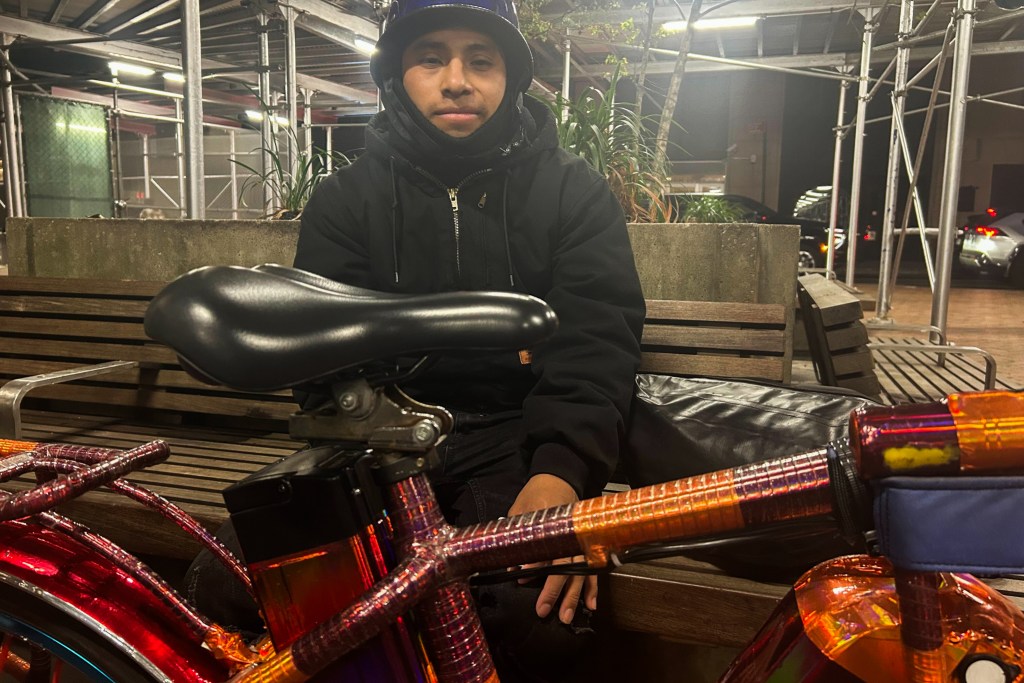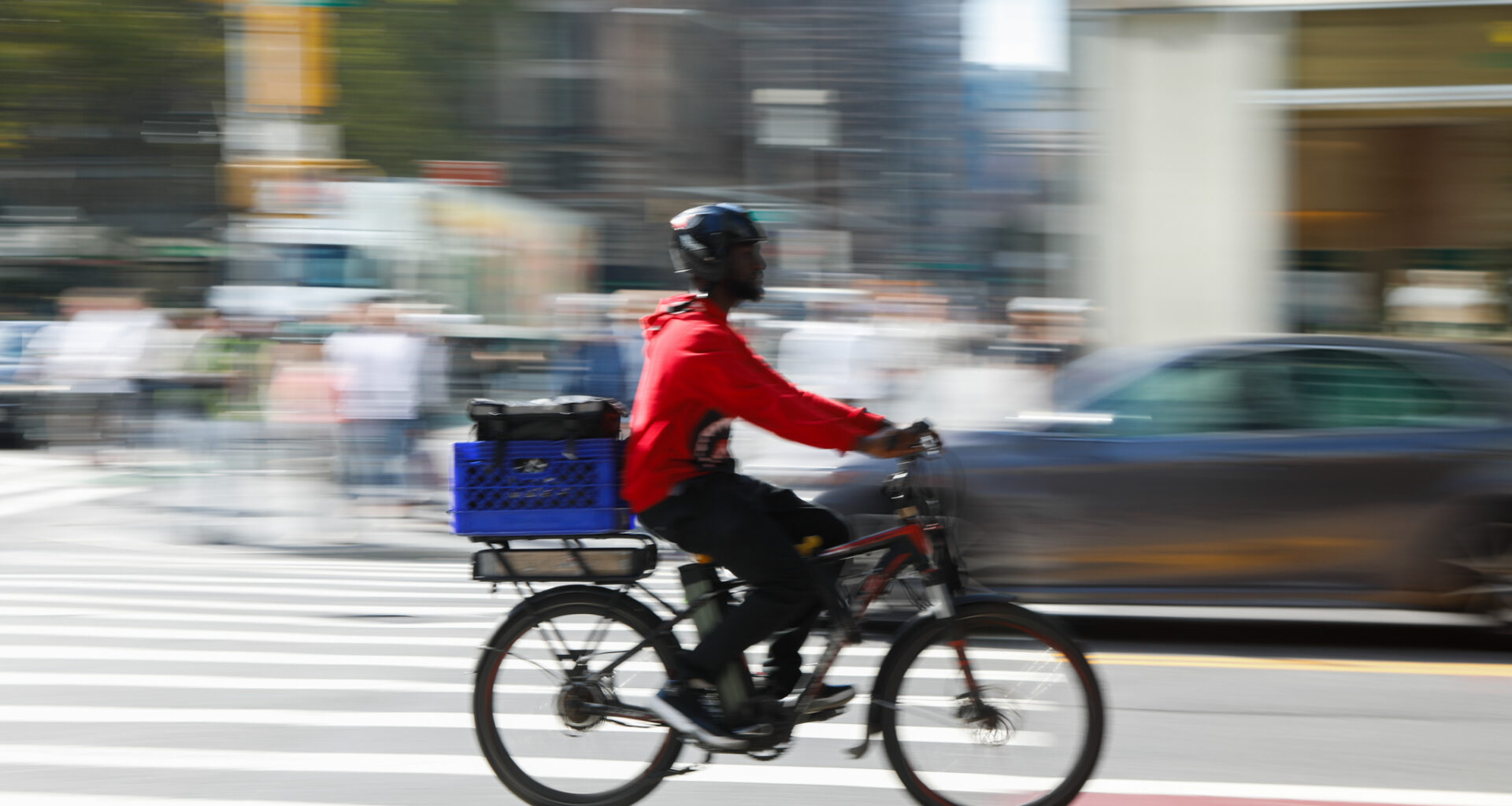The speed limit for e-bikes and pedal-assist bicycles will dip to 15 mph later this month — but questions remain on just how, or if, the city actually plans to enforce it.
The speed restriction will take effect Oct. 24, months after Mayor Eric Adams cited New Yorkers’ safety concerns while announcing a plan to slow e-bikes and scooters.
“I have heard, over and over again, from New Yorkers about how their safety — and the safety of their children — has been put at risk due to speeding e-bikes and e-scooters, and today, our administration is saying enough is enough,” Adams said at the time.
A day after announcing the mandatory speed limit, First Deputy Mayor Randy Mastro ordered Lyft — which owns and operates Citi Bike — to immediately cap the speed of its fleet of pedal-assist bikes at 15 mph.
The change is set to especially impact the legions of delivery workers zipping through city streets on e-bikes.
Ibrahim Diallo, a 28-year-old delivery cyclist who picks up work on Door Dash and Uber Eats, was waiting for a delivery in Times Square on Wednesday when he first learned about the upcoming speed limit change.
Diallo said he always stays south of the new mark.
“If the road is good, I go 12,” he said, showing the speedometer on his e-bike. “If it’s not, I go much slower.”
“I pay attention when there’s more people on the road, I respect the lights.”
Another delivery worker who was awaiting his next dispatch in Lower Manhattan added that speed is central to the job, adding that his e-bike’s top speed is 25 mph.
 Delivery worker Abdiascoy speaks in Lower Manhattan about using an e-bike, Oct. 14, 2025. Credit: Jose Martinez/THE CITY
Delivery worker Abdiascoy speaks in Lower Manhattan about using an e-bike, Oct. 14, 2025. Credit: Jose Martinez/THE CITY
“We’re always on the run so we can make the money,” said the man, who goes only by Abdiascoy. “But we have to respect the rules set by the city — if not, that would be bad for us.”
Lyft had already capped its e-bikes at 18 mph after negotiations with the Adams administration last year.
“We have requested that you immediately implement this new 15 mph speed limit for Citi Bike e-bikes, and you declined to do so,” Mastro said in a letter sent to Lyft. “We therefore have determined that an emergency threat to life and property exists.”
The speed limit is one way government officials have looked to tamp down on speeding e-bikes, including those used primarily by delivery cyclists.
A bill from City Councilmember Robert Holden (D-Queens) that would require the bikes to be registered and have license plates was named for Priscilla Loke, a pedestrian who was fatally injured after being hit by an e-bike rider in Chinatown in September 2023.
In September, the Council also proposed a ban on the sale of e-bikes that go over 25 mph. Both bills are still pending in the City Council.
Which vehicles are affected by the new speed limit?
The speed limit is for anyone operating e-bikes, electric scooters or pedal-assist commercial bikes, according to the Department of Transportation’s adopted rule — which received more than 800 comments during its public process.
Notably, the new rule does not apply to traditional bicycles, which can still move up to 15 mph. Why? The DOT cited the weight of a regular bicycle compared to e-bikes.
“Human-powered devices would not be subject to this lower speed limit because they are lighter devices compared to e-devices, which are heavier due to their motor and battery,” the agency wrote in its adopted rule.
Critics of the change have said a lowered speed limit could hurt the largely immigrant ranks of delivery workers. The DOT continued to cite the safety risk, saying “e-bikes traveling at high speeds present a serious danger to public safety.”
As more people have come to use e-bikes in recent years, the number of injuries caused by and suffered by e-bike riders in the city has been rising. But it is very low when compared to the larger pool of traffic-related injuries. According to Streetsblog, drivers of cars and trucks were responsible for 99.96% of pedestrian injuries reported to the NYPD in the first three months of 2025.
Advocates opposed to the new speed limit say enforcement just exposes undocumented workers to law enforcement.
“Coming on the heels of the NYPD’s policy to criminalize e-bike infractions, it hands police even more discretion to discriminate against deliveristas, who will undoubtedly be its primary targets,” Ligia Guallpa, executive director of the Workers Justice Project, said in a statement. “Instead of holding app companies accountable for unsafe practices and workers’ rights, the mayor has shifted the burden of street safety entirely onto vulnerable immigrant workers.”
Others said the speed limit is hard to enforce and are pressing for other changes, especially those outlined in Priscilla’s Law, to make the roads safer.
“This is a bad joke. At age 88 I would not survive being hit by a bike going 2 mph let alone 15,” Yvonne Groseil wrote in a public comment in response to the new rule. “We need Priscilla’s Law to get visible licenses on these vehicles.”
Daniel McNickle said that riding an electric cargo bike from his home in Riverdale to his job as a science teacher at the Bronx High School of Science takes him 15 minutes. That’s down from his previous 40-minute commute on foot.
“As a cyclist it’s always made me feel safest when I’m moving the same speed as traffic,” he said, noting that he does not go much faster than 15 mph, mindful of the pending limit. “Cars whizzing by is dangerous. Anytime there’s a speed difference on the road, that creates an opportunity for collision.”
He said the bigger issue is cyclists not obeying traffic laws and the city’s bike infrastructure, which needs improvements.
He sometimes rides with his kids, ages 4 and 7, but said those trips come with restrictions, too.
“I would love to be able to go more places with them,” he said. “But the routes that I can take are limited because of safety concerns.”
How will it be enforced?
So far, it’s unclear how the speed limit will be enforced.
A spokesperson for the NYPD, who did not provide their name, wrote in an email that the speed enforcement will be utilized “as a secondary violation when we witness other violations” for cyclists. Police will also add digital speed signs along four major bike lanes in Manhattan to deter speeding, and officers and traffic agents will be out with Department of Transportation staff to educate riders.
DOT did not respond to multiple emails seeking comment and information.
Earlier this year, the NYPD changed its enforcement policy to give e-bike cyclists criminal summonses instead of traffic tickets for offenses that include running red lights or riding recklessly. This requires someone to go to criminal court instead of traffic court.

The shift is part of broader quality-of-life enforcement from Adams and Police Commissioner Jessica Tisch. But it’s not clear if future speeding infractions will be addressed with criminal summonses or just tickets.
Jon Orcutt, director of advocacy for the non-profit Bike New York, said he hasn’t seen anything in terms of education or enforcement for e-bike riders.
“The traditional way of enforcing speed limits is to put up signs, and there’s so far none of that,” he told THE CITY.
“And what would the signs be? Would you have a sign every so often throughout the city saying ‘15 mph — just e-bikes, remember, not your other bikes.’”
Related

